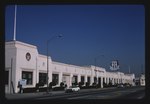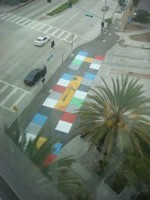Old Growth (New/Now)
2017 sculpturesAmerican contemporary artArt in CaliforniaArt in Greater Los AngelesBuildings and structures in Culver City, California ... and 3 more
Culture of Los AngelesInstallation art worksOutdoor sculptures in California

Old Growth (New/Now) is a large scale exterior public art installation by architect and artist Alison Wright. It is located opposite to the Culver City Metro Station.Electric poles and cross arms support 56 pieces of glass. Historic images from the archives of Southern California Edison and the Culver City Historical Society are placed on one side of the glass. The glass panels on the other side form a Douglas Fir tree, a type of tree that wood utility poles originated from. Unlike typical utility poles, these 40’ tall poles are not connected by power lines. The glass panels are backlit by solar energy via solar panels.
Excerpt from the Wikipedia article Old Growth (New/Now) (License: CC BY-SA 3.0, Authors, Images).Old Growth (New/Now)
Washington Boulevard,
Geographical coordinates (GPS) Address Nearby Places Show on map
Geographical coordinates (GPS)
| Latitude | Longitude |
|---|---|
| N 34.029 ° | E -118.3865 ° |
Address
Apple
Washington Boulevard 8777
90232
California, United States
Open on Google Maps










